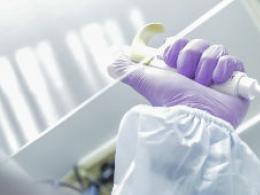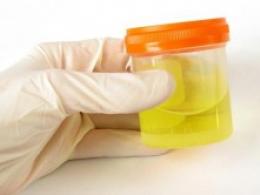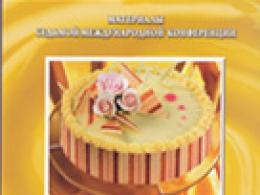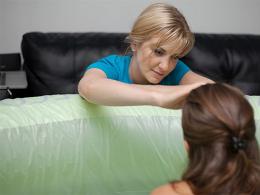Will a simple pencil be washed off the fabric. How to remove a stain from a simple pencil. A few simple rules
Greetings to all needlewomen on the blog "". A rare embroiderer can boast of high speed when working, usually the process stretches for several months, if not years. This is not bad at all - everyone has their own pace and their own preferences. But during the work with the canvas, anything can happen, and most often, what needlewomen have to deal with is spots on embroidery. How to deal with them and what to do so that the spots do not appear?
Usually I try to give only verified information on the blog, share my own experience, telling real facts. Therefore, I could not start an article about stains on embroidery for a long time - it’s just that usually I didn’t have any stains on the canvas. With the exception of traces from a simple pencil, which I wrote about when showing my work "", as well as traces of chocolate, which were easily washed off with.
So I had to open an experimental site, which unfolded interesting for myself and for the observer-son. Trying to wash off all kinds of stains is not a task for the faint of heart, so I “set” only the running ones - from tea, from berries and ... a simple pencil. 🙂
But let's talk about everything in order.
What should I do to prevent stains from appearing on embroidery?
Ideally, of course, to do embroidery outside the kitchen area and without little helpers who strive either with a marker or with paints to help mom in the process of creating a picture. For the time when you are not embroidering, put the fabric in a bag, thus protecting it from all sorts of accidents and dust.
However, this does not always help to protect yourself from all sorts of stains.
The most important thing to remember is that fresh stains are best removed. The sooner you notice the stain and start removing it, the more likely it is to remove it without consequences for the canvas and floss.
However, old spots on embroidery are not a sentence either. They just might require more effort and options to work.
True, using too many funds at once is also not worth it - you can completely ruin the canvas and the work as a whole.
How to prevent molting floss
If during embroidery you notice that the threads paint your fingers or canvas, I advise you to rinse the embroidery in vinegar water before the main wash: dilute a tablespoon of 9% vinegar in 3-5 liters of cold water and hold the canvas in the solution.
Important! If you used a marker for marking, wash it off first. cold water and only then dip the embroidery in vinegar.
This method allows you to "fix" the paint and will not allow the threads to shed. In addition, it will help to make the colors more vivid, saturated. Therefore, I recommend lowering the entire work into a solution of vinegar, and not one fragment.
If the threads have already shed, you will have to be patient and cold water. Pour ice water into the basin (you can even throw ice cubes) and leave the work in the water for an hour, then change the water back to ice water.
How to get stains out of embroidery
Now let's talk directly about the stains that may appear from various kinds of products.
Tea or coffee stains
I don’t have coffee in my house, but the tea stain turned out to be the most harmful. So I do not advise anyone to drink tea next to the embroidery - you can seriously ruin the work. And the only option would be to repaint the entire canvas. 🙂 After all, this known way make a unique canvas with a light (in case of a weak tea solution) or bright (in case of strong tea leaves) “pattern”. But we are not interested in creating a new shade, but in removing tea stains.

It is possible that if the tea is not strong and rinse the work immediately, the fabric will brighten. BUT this advice did not help me - the canvas with the stain lay for about five minutes and there was no longer any sense from cold water.

Washing with laundry soap improved the situation a little, but still the tea stain remained.

The photo is not so noticeable - you need to look closely, but from afar on a white background it is clearly visible.
You could try Vanish, it is often used by embroiderers to remove stains. But I do not have it. Another tip says: rub with lemon or soak in lemon water (tablespoon lemon juice per glass of water)

As a result, only bleach for baby clothes coped with the task (for a long time I have been using only powder and bleach "Eared Nanny" - when in the house Small child otherwise it doesn't work.)

Although, too, it seems to me, if you look closely, you can still notice a slight shade of tea ...
Grease spots
FROM greasy spots usually any dishwashing detergent will do the job well. The only thing is that you should first try to soak only the threads in it - to check if they shed or fade. Wash in warm water and it is advisable not to soak the finished work in the product for a long time. And then it is important to rinse the embroidery very well.
Stains from berries, red wine
With red wine, my house is also tense, as with coffee. But the freezer is full of berries - regularly in a saucepan there is fruit drink for my son. Here is one cranberry ruthlessly crushed on the canvas. 🙂

Pay attention to how “successfully” it turned out - there is a light area and a darker one. This, as it turns out, is important too.
The advice that made me experiment with the berry is to use boiling water. It is important to take boiling boiling water and stretch the fabric on the hoop. Be careful with the ferry!
I poured one and a half liters of boiling water from the kettle onto a small spot. However…
A weak trace of a berry can still be removed in this way, but a strong one, alas, no.

Laundry soap partly exacerbated the problem - part of the stain went away, and part became purple. I suppose it’s also because I already washed it in warm water, because it’s simply not realistic to wash the fabric with your hands in boiling water.

Next came the bleach. In general, of course, at first it would be necessary to try the stain remover of the same brand that I mentioned. He usually copes with berry stains on ordinary T-shirts. But here I didn’t have it, so I immediately applied the “radical” option.

The bleach did the job, BUT, notice that part of the canvas has also bleached. This is barely noticeable to the eye, because the canvas is cream, but this means that it is permissible to use bleach only on white fabric and it is advisable not to allow undiluted bleach to get on floss and colored canvas. That is, it is worth diluting the product a little, and only then use it.
blood stains
Sometimes it happens to be pricked with a needle while sewing, because blood stains can also appear on the embroidery. But here, sorry, I didn’t specifically cut my fingers. 😀 If someone really tried some active means, I will be happy to read your opinion in the comments.
As for the advice on the Internet (which, as you have already seen, can not always be trusted 😉 , it is suggested to remove the stain with hydrogen peroxide or saliva. To do this, moisten a piece of white thread with saliva and apply a wet lump to the stain, most of the stain should come off thread, and the rest can also be removed in cold water.In general, the blood usually washes well in cold, almost ice-cold water.So, it may be worth holding it under cold water first, and then using saliva or peroxide.
Markers and pencil marks
Often there are questions about how to remove a mark from a marker or a simple pencil, so let's talk about this type of stain on embroidery.
How to remove a marker
Recently, I was asked if the marker would wash off if it was applied to the canvas a couple of years ago. To be honest, I haven’t marked the canvas for a very long time, but it was on it that I made a small markup about seven years ago.

Here it is barely noticeable - the camera, of course, cannot convey as accurately as possible. But I note that in reality the trace of a water-soluble marker is not so noticeable - it has faded over time.

If you used cold water, but for some reason the marker did not come off right away, hold the embroidery in ice water for an hour. Should help.
But if you rinsed the embroidery in warm water and the marker “fixed”, then, I believe, either a stain remover-bleach will help, or ... nothing. Perhaps one of my readers knows how to deal with such stains - share your experience in the comments! 😉
How to remove a simple pencil from embroidery
But the surprise for me was the removal of markings from a simple pencil. At the very beginning of the existence of the blog, she shared her experience and warned all beginner embroiderers
DO NOT use a pencil for marking the canvas!

this stain from a simple pencil remained on my work
But novice embroiderers continue to step on this rake, so they often ask themselves: “ How to remove pencil from embroidery?».
And finally, a solution has been found. Laundry soap. Not simple, Soviet, but Japanese. With the effect of boiling.

Yes, not everyone can sell it. I know that Vanish soap (namely soap) has a similar effect. But I had soap as in the photo ...

I made the markup with a hard pencil (left) and soft (right). Specially many times moved with a soft simple pencil, so that the trace remained decent.
But, to my joy, the soap perfectly washed off both the markings with a hard and soft pencil.

Without excessive effort, but with "bumping" and friction, which, as you remember, is undesirable. Therefore, I still continue to insist - for marking the canvas, please use or choose another, suitable method. I wrote about them in an article -
If the spots on the embroidery still have not disappeared
Don't be discouraged if you tried different variants, and the stains did not succumb. It is possible that the work will not be completely ruined if you are smart and creative. 😉
Show your imagination and sew up the soiled fragment: add another row or two of crosses or half-crosses to the embroidery, add some fragment - for example, when embroidering landscapes - sew on a flower, a bush or an asterisk.
Or try to pick up one in a framing workshop that will help hide the defect.
Do you have experience removing stains on embroidery? Have you successfully managed to remove traces of coffee from the canvas? Or maybe you tried some other ways to remove stains on embroidery that I did not mention? Share your experience in the comments!
A battered movie image with a trace of red lipstick on the collar of a white men's shirts hints at a romantic plot twist. AT real life makeup stains on your favorite dress or bag are more likely to turn into tears.
Dropped your nail polish brush on your new jeans? Met brightly painted lips with a scarf? Or - well, who hasn't happened to - erased the foundation from the face with the collar of a T-shirt? Before you panic and furiously rub the stained item with a tissue, take a deep breath and calmly get down to business. We'll fix everything! Especially if you follow the instructions.
PHOTO getty images
General rules for stain removal
1. Fresh (not older than three hours old) stains are easier to remove than dried and firmly absorbed. Therefore, we must act quickly.
2. If the stain is fresh, first blot it with a dry paper towel so that it absorbs as much as possible. cosmetic product. Now sprinkle the stain with salt or baby powder, they absorb grease very well.
3. If several hours have passed since the incident, the stain has dried up, remove the top layer with a plastic spoon.
4. Remove the stain from the wrong side of the fabric by placing paper towels under the bottom.
5. Never rub the stain: it will only absorb more thoroughly. The movements should be soaking.
6. When buying a stain remover, be guided by the type of stain and the type of material that needs to be cleaned. Read the instructions first and strictly follow them.
7. Any stain removers, both home-made and industrial, first test on a small area of \u200b\u200bthe fabric, not the most noticeable part of the product. If the color remains the same, you can proceed.

8. Start removing dirt with a weak solution. If necessary, gradually increase the concentration.
9. Peroxide and other stain-fighting products should not be poured onto the stain, but applied with soaked cotton pads or a soft-bristled toothbrush (for example, for the smallest children). First treat the area around the stain, then the edges, and only then take the middle. This technique will not allow the stain to blur.
10. After local processing, wash the item completely. First, read the information on the label on the care of the affected item: what is allowed for silk is not allowed for linen.
11. Do not attempt to remove stains or their remnants in washing machine, especially with the drying mode on. After that, it will be almost impossible to remove traces.
Process
Beauty products can be oil-based (creamy) or fat-free (powdery). From this will curl the choice in the store or home preparation of a solution for removing cosmetics. An all-purpose product that works on most types of stains - diluted in water ammonia with salt, but he is not omnipotent. Therefore, we will deal with each type of cosmetics in more detail.

All of these and other creamy beauty products are mostly oils and/or waxes. Plain water does not wash them, on the contrary, it will aggravate the situation. You will need products that dissolve fats.
First way. The easiest and most affordable means to remove traces of lipstick or tone from fabric is dish detergent or shampoo. Take something that does not contain moisturizing ingredients - excess fats in this case are useless. After the steps with a napkin and salt, apply a little (a couple of drops in a 1:2 ratio to water is enough) and leave for five minutes. Then wash off with warm water.
The second way. Spray the stain with hairspray. Leave on for 10 minutes, then wipe with a clean cloth or sponge. Wash.
Third option. Sprinkle baking soda on the stain, and after a few minutes extinguish with a mixture of warm water and lemon juice or vinegar. And send it to the laundry.
Number four is a 3% hydrogen peroxide solution. It is especially effective against self-tanners and other cosmetics with orange pigment.
Sprinkle traces of blush, shadows, powder with washing powder. Wash after 15 minutes using the method recommended for the affected item.

Mascara and eyeliner
It is not for nothing that for mascaras and eyeliners, especially waterproof ones, special two-phase removers are produced: you can’t get rid of them just like that. It makes sense to use these make-up removers if the mascara is not only on the eyelashes, but, for example, on the sleeve. Proceed according to the protocol: shake the bottle well, apply a little liquid on a cotton pad, lightly blot the stain and wash. To avoid messing around with oil stains from a two-phase tonic, use micellar water. It consists of special particles, micelles, that stick to dirt molecules and are washed away with them.
Removing regular (non-gel) nail polish from fabric is almost as easy as removing it from nails. Just don't reach for the bottle of acetone. If you accidentally spilled nail polish on your dress, let it dry and then stick tape over it. Tear off the tape with a sharp movement, as if it were a wax strip for epilation. The varnish should leave a pale mark, which will be removed by the washing machine. If trouble happened to your favorite leather jacket or bag, after removing the stain, apply leather furniture conditioner to the damaged area. Follow the instructions on the package and don't forget to wear rubber gloves.

Hair dye
Hair dye marks on a towel or T-shirt are some of the most difficult cases. If a cocktail of equal parts of ammonia and hydrogen peroxide or ammonia and water in a ratio of 1: 5 with the addition of salt (a teaspoon per glass of solution) does not help, you will have to buy a stain remover. Or use this thing for further hair coloring at home.
If the stain did not get rid of on the first try, repeat one or more times until the end. If all else fails, go to the dry cleaners.
Many “old-fashioned” needlewomen use a pencil to mark seams, patterns and ornaments. However, removing a simple pencil from canvas and white fabric is not an easy task. Special tools that are easy to prepare at home will help to cope with strokes.
Recipe for an effective soap remedy. Required components:
- soap "Antipyatin";
- laundry soap;
- oxygen bleach;
- synthetic detergent;
- dishwashing liquid.
Cooking:
Mix the ingredients in one bowl, mix thoroughly. Apply the prepared product to the contaminated surface, leave for a day, and then soak in warm water for 7-8 hours. If marks remain, add some synthetic cleaner to the water. Rinse the fabric well under running water to remove any residue. Wash additionally in a washing machine with a suitable programme.
How to remove a simple pencil from embroidery and canvas?
If you need to remove pencil marks very quickly, use ready-made stain removers - As or Vanish. Before washing, be sure to read the instructions to avoid negative consequences. The cleaning powder can be added to the wash or applied directly to the stained area. There are products designed for colored and white fabrics. Keep this in mind when choosing them.

How to remove pencil from white fabric?
You will need a simple laundry soap that will help to cope with stains no worse than expensive products. Soak the contaminated cloth in warm water, carefully rub the place of contamination with a piece of laundry soap, leave for half an hour. Rub the cloth again with soap and rinse thoroughly. Additionally, wash it in a washing machine with a suitable mode.

How and how to remove a pencil from canvas
Another simple but effective remedy- Antipyatin soap. It is used in the same way as laundry soap. Soak the contaminated area, rub thoroughly with a piece of soap, let it lie for 20 minutes, rub with soap again and rinse well in clean water. It remains only to wash the product in the washing machine.
A few more effective ways:
- Gel Vanish. Prepare a plastic cup, pour a little gel into it (about halfway). The amount of gel will depend on the size of the contamination. Put in a bowl (without water) and leave for 4 hours. Add water, rub the contaminated places with laundry soap, leave again for several hours. Scrub the fabric with a brush (light movements), rinse and wash in the washing machine. If contamination remains, repeat the procedure again.
- If you are using a marking pencil, starch the fabric before embroidering. After finishing work, simply wash the product with detergent. The neck marks will easily come off with the starch.
- If the marks are not very strong, try erasing the pencil with a simple school eraser.
- Pour warm water into the basin, add 2-3 caps of Ariel, stir the contents a little, immerse the embroidery or sewing, stir again and leave overnight. In the morning, wash the product, rinse in clean water.
- Treat the fabric with detergent, rinse in cold water, add 2-3 drops of ammonia, treat the fabric again with detergent and rinse in clean water.
- From bread crumb roll up a small ball, put it in the palm of your hand and “roll” it over the contaminated surface. Bread crumbs literally "roll out" the traces of the neck. For starters, you can practice on paper. Finally, blow off the breadcrumbs and launder the items if necessary.
- If all else fails, try drastic measures. For example, use WD-40. Spray a small area, and then gently rub with a cloth. If the fabric is delicate, try this application method. Spray paper towels with WD-40 and apply to the stain on both sides. Leave the wipes on for 2 minutes, rub a few drops of dish detergent into the stain. Gradually, the napkins will begin to stain, absorbing traces of the pencil. Change napkins every 2 minutes. Wash the fabric in the washing machine.
- If you need to remove crayon from upholstery or carpet, try using a dull knife. After most of the dirt has been removed, moisten it with WD-40 and leave for 5 minutes. Scrub the mark with a stiff brush, treat with a paper towel, drip WD-40 again, add a couple of drops of detergent, rub the mark with a brush, moisten with a damp washcloth.
Traces from a simple and colored pencil are very difficult to remove. To mark up embroidery patterns, it is better to use special markers or thread. Traces on furniture upholstery and carpet are removed for a long time. But, the result is sure to come. If one method doesn't help, another will. The main thing is not to give up!
Have you been lucky enough to become the parents of a young talent for whom the whole house is an artistic canvas? A child turns walls, furniture and other objects into intricate art objects, and you grab your head thinking how to clean it all up?
Indeed, when new wallpapers are covered with sweeping scribbles, it is difficult for mom to rejoice - after all, it is she who will have to shed sweat in the fight against the "masterpiece".
Calm, just calm. the site will share with you simple tricks that will help remove traces of children's creativity from various surfaces and return the apartment and clothes to their original appearance.

Let's start with the most innocuous art tool - a pencil. To cope with traces of both a simple graphite pencil and its colored counterpart, it is enough to use a soft eraser. It is necessary to erase the slate trace from the embossed wallpaper with extreme caution, do not be zealous so as not to damage the canvas.
You can remove the pencil from the fabric using a toothbrush with a drop of dishwashing detergent. The fabric must be gently rubbed and then washed.

If the child chose walls covered with paper wallpaper as a picturesque object, then we have bad news for you. It will not work to reanimate such wallpapers. It remains only to come to terms with the upcoming repairs. But with vinyl wallpaper, watercolor or gouache can be washed off with soapy water at room temperature.
Gouache and watercolor can be easily removed from clothes with any oxygen bleach.

When buying a set of felt-tip pens for a child, it is worth making a choice in favor of children's felt-tip pens with water-based rather than alcohol-based ink. This will make your life much easier in the future. The water-based paint of such a felt-tip pen is easily erased from the surfaces with a damp sponge soaked in soapy water.
If your little one got to your permanent markers, or if you accidentally bought alcohol markers for children's creativity- do not be upset. Although it is more difficult to remove such paint, it is possible. Attack the stain with the usual penny hydrogen peroxide, use oxygen bleach, or make your own stain remover - take 1 part baking soda, 1 part alcohol, mix, wet a cotton pad and gently rub the stain with it. Be careful not to smudge! In the fight against art, move from the edge to the center of the colorful patch.
A fabric stained with a felt-tip pen can be cleaned, including with soda. Pour a little powder onto a damp sponge and go over the stain. Unfortunately, tissue fibers are slightly injured in this case.

The basis of the mixture for wax crayons is paraffin and coloring pigments, and therefore the stroke from this artistic tool turns out to be greasy and does not erase well. But the kids are very fond of drawing with them, because the picture comes out so bright, “juicy”! But it happens that the kid is too fond of creativity and forgets that you need to draw on the paper intended for this. To get rid of an unauthorized masterpiece, you need to use an iron. Apply printer paper or old newspaper to the wax mark and iron the surface with a hot iron soleplate. Repeat the procedure until the paper is no longer clogged. Then apply dry baby powder to the place of the astrakhan fur and let it soak up the rest of the paraffin.

Pen paste is one of the worst evils, which is quite difficult to deal with. Try making and using this stain remover: mix one part acetone (contact your husband, he should have it in the garage) and one part alcohol, dip an ear stick in the solution and gently wipe the mark from the pen, avoiding the unaffected surface. Change the cotton swab as it gets dirty. Instead of acetone, you can use acetone-based nail polish remover. Or try removing ink blots with chlorine bleach. Be careful - all these tools are aggressive! Take precautions.
The safest way to remove stains from clothes ballpoint pen- this is spoiled milk. Soak the fabric in it for several hours, and then wash it in soapy water with a couple of drops of ammonia.

If a young sculptor grows up in your family, who decorates his father's house with intricate plasticine stucco, then the rooms are probably full of traces of this type of creativity. We can offer several methods of salvation from greasy plasticine stains at once. The first method is perfect for cleaning the surfaces of tables and chairs: take a piece of ice and attach it to plasticine, then use a spatula to scrape off the hardened mass. Don't delay! If you miss the moment, the greasy component of the material will saturate the surface and it will become problematic to get rid of the stain.
If a child dropped his masterpiece on the carpet, where it was thoroughly rubbed into the villi, then the affected surface must be “treated” with an iron. The method was described above when we talked about how to get rid of stains after wax crayons.
To clean clothes, put them in the freezer until the plasticine is completely petrified. Then, try to remove the adhering material mechanically. Next, treat the “problem” place with soapy water and leave for 15 minutes, after which rub the stain with a toothbrush (you can use soda).
From paper wallpaper, greasy traces of plasticine, alas, cannot be removed. It remains only to conclude that such wallpapers are not suitable for a home where children grow up.
Concerning plasticine selection, now there is an excellent alternative to the usual classic - wax clay. It is more plastic and easier to mold, and most importantly, it gets less dirty! There is another option - soft plasticine in jars, which hardens in the air. Yes, dried material is not suitable for reuse, as it becomes brittle and crumbles easily. But on the other hand, such a craft, forgotten somewhere on the carpet, will not melt in the heat and will not upset you with a colored puddle that has eaten into the surface.
Tips for parents of little art lovers

All children love to draw and sculpt. In addition, creative activities are useful for fine motor skills and contribute common development child. Therefore, it is impossible to interfere with children's arts, even if the child spoils the furniture. Try to explain to the baby that there are specially designated places and surfaces for drawing and sculpting, but do not rely too much on obedience. For your part, you can minimize the level of damage by investing in easy-to-wash water-based art supplies for kids. If you are making repairs, consult a specialist before buying material for walls, tell them that a child is growing up in your house.
If the child is still too young to accept your rules creative process and it is not possible to fight with the arts, and there are no plans for repairs - it is necessary to provide the young creator with all the conditions for self-realization. Protect the wallpaper by attaching sheets of thick Whatman paper to the walls.
Each child is the pride of his parents, the fruit of their joint creation. A talented child is doubly proud. Stock up on patience in your good work of raising offspring and rejoice in the success of your child - after all, this is your success, do not forget! And ruined wallpaper, after all, is just a piece of paper.
Be happy!
Many “old-fashioned” needlewomen use a pencil to mark seams, patterns and ornaments. However, removing a simple pencil from canvas and white fabric is not an easy task. Special tools that are easy to prepare at home will help to cope with strokes.
Recipe for an effective soap remedy. Required components:
- soap "Antipyatin";
- laundry soap;
- oxygen bleach;
- synthetic detergent;
- dishwashing liquid.
Cooking:
Mix the ingredients in one bowl, mix thoroughly. Apply the prepared product to the contaminated surface, leave for a day, and then soak in warm water for 7-8 hours. If marks remain, add some synthetic cleaner to the water. Rinse the fabric well under running water to remove any residue. Wash additionally in a washing machine with a suitable programme.
How to remove a simple pencil from embroidery and canvas?
If you need to remove pencil marks very quickly, use ready-made stain removers - As or Vanish. Before washing, be sure to read the instructions to avoid negative consequences. The cleaning powder can be added to the wash or applied directly to the stained area. There are products designed for colored and white fabrics. Keep this in mind when choosing them.
How to remove pencil from white fabric?
You will need a simple laundry soap that will help to cope with stains no worse than expensive products. Soak the contaminated cloth in warm water, carefully rub the place of contamination with a piece of laundry soap, leave for half an hour. Rub the cloth again with soap and rinse thoroughly. Additionally, wash it in a washing machine with a suitable mode.

How and how to remove a pencil from canvas
Another simple but effective remedy is Antipyatin soap. It is used in the same way as laundry soap. Soak the contaminated area, rub thoroughly with a piece of soap, let it lie for 20 minutes, rub with soap again and rinse well in clean water. It remains only to wash the product in the washing machine.
A few more effective ways:
- Gel Vanish. Prepare a plastic cup, pour a little gel into it (about halfway). The amount of gel will depend on the size of the contamination. Put in a bowl (without water) and leave for 4 hours. Add water, rub the contaminated places with laundry soap, leave again for several hours. Scrub the fabric with a brush (light movements), rinse and wash in the washing machine. If contamination remains, repeat the procedure again.
- If you are using a marking pencil, starch the fabric before embroidering. After finishing work, simply wash the product with detergent. The neck marks will easily come off with the starch.
- If the marks are not very strong, try erasing the pencil with a simple school eraser.
- Pour warm water into the basin, add 2-3 caps of Ariel, stir the contents a little, immerse the embroidery or sewing, stir again and leave overnight. In the morning, wash the product, rinse in clean water.
- Treat the fabric with detergent, rinse in cold water, add 2-3 drops of ammonia, treat the fabric again with detergent and rinse in clean water.
- Roll a small ball out of the bread crumb, put it in the palm of your hand and “roll” it over the contaminated surface. Bread crumbs literally "roll out" the traces of the neck. For starters, you can practice on paper. Finally, blow off the breadcrumbs and launder the items if necessary.
- If all else fails, try drastic measures. For example, use "WD-40". Spray a small area, and then gently rub with a cloth. If the fabric is delicate, try this application method. Spray paper towels with WD-40 and apply to both sides of the stain. Leave the wipes on for 2 minutes, rub a few drops of dish detergent into the stain. Gradually, the napkins will begin to stain, absorbing traces of the pencil. Change napkins every 2 minutes. Wash the fabric in the washing machine.
- If you need to remove crayon from upholstery or carpet, try using a dull knife. After most of the dirt has been removed, moisten it with WD-40 and let it sit for 5 minutes. Scrub the mark with a stiff brush, treat with a paper towel, drip the “WD-40” again, add a couple of drops of detergent, rub the mark with a brush, moisten with a damp washcloth.






